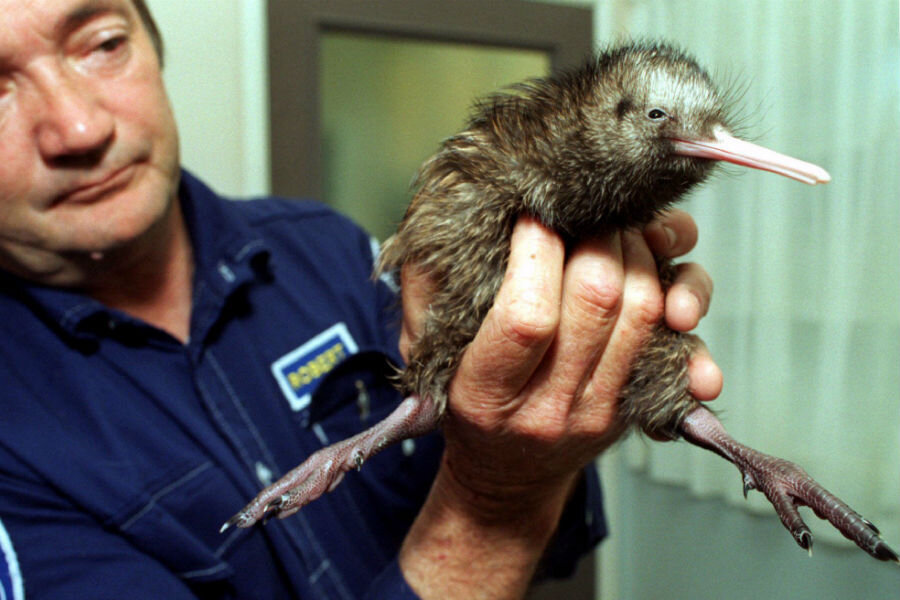How New Zealand aims to wipe out all rats and other invasive predators
Loading...
New Zealand has announced a plan to make the country free of rodents and other invasive species that threaten its natural species by 2050.
Never before has such an ambitious program been tried for such a large area.
"It's wonderful that they're going to attempt to do this, it's certainly on an unprecedented scale," Sarah Dawson, the director of the Wohlsen Center for Sustainable Environment at Franklin and Marshall College, tells The Christian Science Monitor. "It's never been attempted for such a large area or for species that are so difficult to control."
The government plans to initially put $28 million into a new project, Predator Free New Zealand Ltd, which will provide money on a "one for two" basis, offering $1 of funding for every $2 local governments and private companies contribute. Predator Free New Zealand intends to identify promising large predator control projects and work to bring on co-investors, as New Zealand news website Stuff reported.
"Rats, possums, and stoats kill 25 million of our native birds every year, and prey on other native species such as lizards and, along with the rest of our environment, we must do more to protect them," New Zealand Prime Minister John Key, who announced the initiative, said.
Since many birds in New Zealand had evolved to become ground-dwellers when they had no competition from mammals on the island, they were especially vulnerable when humans and the predators they brought with them arrived on the islands.
The Kiwi, the national symbol of New Zealand, is an endangered species that dies at a rate of 20 each week, as The Guardian reported. There are now fewer than 70,000.
Now, this generation of humans on New Zealand wants to reverse the harm their species has done to the natural environment.
New Zealand has been a leader on eradicating predators of endangered species, Mark Hoddle, the director of the Center for Invasive Species Research at the University of California, Riverside tells the Monitor. New Zealanders have been able to clear rugged, moderately large islands of rodents, he said.
"It's terrific that the government has stepped up and put some money on the table," Dr. Hoddle said. "It's highly probable within our lifetimes.... There's a good chance we may actually see the benefits of this very aggressive control program, and I think that's exciting."
Although eliminating rats and mice from urban areas will be a major challenge, Hoddle says in more rural areas, "they may have a shot at achieving large areas known to be predator free."
Along with protecting more birds, the flora will "benefit immensely" as well, Hoddle says.
New Zealand officials aim to have 1 million hectares of land where pests are suppressed; develop a scientific breakthrough that could eliminate an entire mammalian predator species; make 20,000 hectares "predator free" without using fences; and complete a removal of alien predators from offshore island nature reserves.
Generally, three steps are taken to fight invasive species, Dr. Dawson says. First, attempts are made to keep the species out of the territory it would invade in the first place. If they do get in, the next step is to aggressively attempt to eradicate the species while the population remains small. If this fails, generally the next step is to just manage the effects of the species. New Zealand's will be the largest attempt at a fourth step, which is fighting already established invasive species.
The invasive species in New Zealand, where Dawson briefly lived, are well-established and difficult to fight, she says.
"Rats, stoats, and possums, they're across the island, they're everywhere," she says. "It's not like they're just in small, little holdout populations."
The species targeted under this new initiative are smaller species that breed more quickly, and live on private land where they are harder to eradicate than public land. There are also welfare considerations for the animals targeted for eradication, which can cause issues with public acceptance or support.
The eradication project could cost up to NZ$9.04 billion (about US$6.32 billion) over 50 years, according to a 2015 paper by New Zealand conservationists. However, the benefits of eradication could total NZ$9.32 billion (US$6.51 billion), the same study found.
There are some technical issues that could stand in the way. Use of chemicals to poison the species, one of the common ways to eradicate invasive species, is unpopular to some members of the general public because of worries that it will affect their pets or other native species. However, Hoddle says research shows the biodegradable 1080 poison, widely used in the country to kill possums, has only a minimal environmental risk.
As for methods, Hoddle says, "I think they're really back to the basics: poisons, exclosures, traps and lethal things."
Expanded use of GPS technology on traps for the mammals and the possibility for future developments has made the 2050 goal possible, Science and Innovation Minister Steven Joyce told the New Zealand news site, Stuff.
"I think what's really exciting is for those of us watching this closely, is that the technology has moved dramatically," he said. "Now you can set them and leave them, link them through GPS, it's about one-seventeenth of the cost to maintain predator control over a piece of land than it was just a few years ago."
New Zealand's project may be a model for future projects, Dawson says.
"The eyes of a lot of conservation biologists are going to be on New Zealand," Dawson says. "It's going to be a major testing ground, and I think they're going to learn a lot of lessons about what's effective, what's not effective, where new technologies or new management strategies need to be employed, and I'm hoping the rest of the world can really learn a lot from what's going on here."
Editor's note: This story originally misspelled Dr. Hoddle's name.








